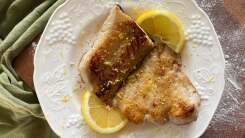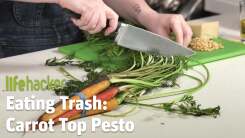The Case for Actually Measuring Your 'Pinch' of Salt
Much like chemistry, getting “good” at cooking is really about consistent, reproducible results, which usually requires a fair amount of measuring (at least at first). The more you cook, the less you’ll have to measure—but it is always best to arm yourself with more knowledge rather than less.
This is all to say I think you should measure your “pinch” of salt whenever a recipe calls for one. I know that sounds a little fussy, but that knowledge could come in handy down the line. For one: not everyone’s fingers can grab the same amount of salt, and a pinch from my tiny, stumpy fingers is probably not equal to a pinch made with long, elegant phalanges.
If you’ve ever had to sprinkle a certain amount of salt over a certain area of meat in order to dry brine it, this information will be useful. For example, I know that my two-fingered pinch grabs about 1/5 of a quarter of a teaspoon of fine sea salt, so if I want to distribute 1/2 a teaspoon of salt over a steak or chop, I know I need about 10 pinches, which I can grab with confidence directly from my salt cellar, negating the need for measuring spoons.
Knowing how much salt is in a pinch is also helpful if you’re scaling up. Let’s say you happen to make a quarter cup of a really banging vinaigrette; you know it took two pinches of salt to make it pop, and you know your pinch is equal to about an 1/16th of a teaspoon. The next time you make that dressing, you can make more of it, using that known variable to ensure your recipe scales up efficiently. (If you want to make 2 cups of dressing, for example, you’ll know that you will need a whole teaspoon of salt.)

You can also measure your pinch by mass (which is what Kenji at Serious Eats does), but you’ll need a fancy kitchen scale to do that. Instead, I like to write down how many pinches it takes to fill 1/4 teaspoon, then do my calculations from there. It is rather fussy—but sometimes some fussiness can make your life a little easier down the road.
RECOMMENDED NEWS

Why You Should Dredge More (and Deep Fry Less)
When people talk about frying fish, they are usually referring to deep frying—or at least that is wh...

Your Next Batch of Pancakes Deserves This Ultimate Maple Butter
When it comes to pancakes, I am a bit of an obnoxious purist. Though I appreciate the occasional cho...

You're Probably Overcooking Your Corn
Hello, it’s me, your friendly internet corn truther, here to tell you that you are probably overcook...

You Should Double-Fry Your Chicken
The best karaage chicken I ever ate was at a Japanese restaurant down in the Bowery area of New York...

How to Make 'I Live Alone' Ganache
One of the perks of living alone is the freedom to interpret the phrase “proper meal” however the he...

How to Turn Corn Into Hominy (aka Nixtamal)
Even if you haven’t eaten straight up nixtamal (known in the Southern US as “hominy”), you have most...
Comments on "The Case for Actually Measuring Your 'Pinch' of Salt" :